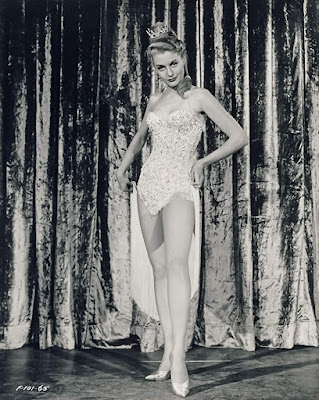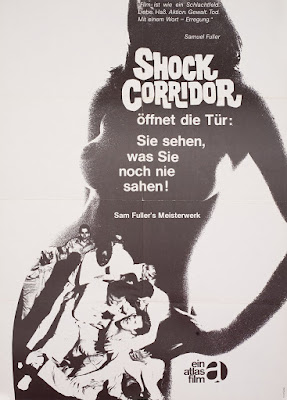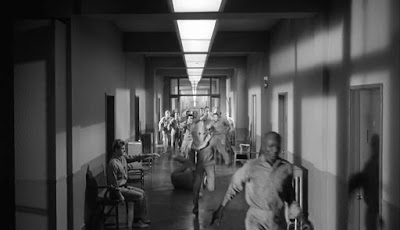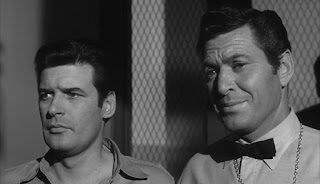 ‘The Criterion Collection’ have recently released a digitally enhanced version of the psychological drama, ‘Shock Corridor’. It was directed by Samuel Fuller; it starred Peter Breck, Constance Towers, and Gene Evans; and it lasts for 101-minutes. Plus, as an extra added bonus, the Blu-ray edition comes with a documentary about Fuller, a new interview with Constance, as well as the original theatrical trailer. Please enjoy.
‘The Criterion Collection’ have recently released a digitally enhanced version of the psychological drama, ‘Shock Corridor’. It was directed by Samuel Fuller; it starred Peter Breck, Constance Towers, and Gene Evans; and it lasts for 101-minutes. Plus, as an extra added bonus, the Blu-ray edition comes with a documentary about Fuller, a new interview with Constance, as well as the original theatrical trailer. Please enjoy.Shock Corridor [The Criterion Collection]
THE STORY:
Who did it? Which one of these lunatics killed Sloan? Come on, man! Use that brain of yours and try to figure this one out! After all, you are a journalist, a really good journalist, and you were smart enough to trick your way into this mental asylum in order to crack the case and write a Pulitzer prize-winning story.
So come on man, think, think hard, and try to deduce who’s the culprit out of the inmates you’ve met so far. I mean, could it be Pagliacci (Larry Tucker)? The fairly overweight ruffian that likes to sing opera! Or how about Stuart (James Best)? A skinny southerner who’s obsessed with the confederacy! Or better yet, maybe the killer is Trent (Hari Rhodes)? Even though he’s an African-American who keeps on praising the KKK.
Either way, I’ve got to get to the bottom of this mess as soon as I can, otherwise, I may go mad, stark raving mad, and totally forget about my lovely girlfriend Cathy (Constance Towers) or who I really am. Me, Johnny the journalist (Peter Breck). But then again, that’s most probably why what next transpires goes, cuckoo, cuckoo, when I start to lose my voice. As an investigation doesn’t know which way to go - a sexy stripper puts on a mean-looking show - a mental asylum likes to grow, blow, and glow - and at the end of the day, please remember, being mad begins when you enjoy eating yellow snow.
THE REVIEW:
Overall, I thoroughly enjoyed watching ‘Shock Corridor’ because it was a rather goofy looking movie which managed to work on three different levels. On one level, it’s a murder mystery, featuring a journalist who tricks his way into a mental asylum so he can investigate the death of an inmate. On another level, it’s a psychological thriller, chronicling the slow descent of said-journalist while he’s carrying out his quest. And finally, on yet another level, it’s a story about despair, tragedy, and obsession, filtered through the three main suspects that the journalist gets to talk to.
So, from a literary standpoint, it’s pretty safe to say that this movie is jam-packed with a copious amount of ideas and ideologies. Yet, that doesn’t necessarily mean that it’s confusing or jumbled to watch! Far from it, in fact, as its basic narrative structure can also be broken down into three distinct parts. Or to be more specific about it, a three-act play. Act One, for instance, introduces us to most of the main characters, including Johnny the journalist, and sets up the initial part of the plot (murder, mystery, and madness). Whereas Act Two, on the other hand, focuses on the journalist's investigation and establishes the three main suspects (Stuart, Boden, and Trent). And finally, Act Three throws a spanner in the works (zap), and suddenly, riddles are solved, dilemmas are put to bed, and characters are surprisingly redefined in a rather disrespectful fashion.
Although, to be fair, the ending of this film wasn't the only thing that was slightly disrespectful to the characters. Not when you take into account that a lack of respect was something that shaped most of their lives. Emotionally, this is reflected in two of the inmates, Trent and Stuart, who were abused as children and explains why they’ve slowly turned mad; along with Cathy, the journalist’s girlfriend, who was assigned a provocative vocation that didn’t bear any relevance to the story being told.
Well, without giving too much away, part of her role in this adventure was to serve as a liaison between the journalist (who's inside the asylum) and his official contact, Swanee (who's outside the asylum). But, for some remote reason, Cathy's also a stripper, a very sexy stripper, who performs a captivating song and dance routine whenever she's not involved with the plot. In fact, her sultry performance was so captivating and so sexy to watch, it kind of felt weird within the confines of a movie about murder, madness, and death, despite it being fairly tame compared to today's more overt standards. Coincidentally, the same thing can also be said about that scene where Johnny was attacked by a group of female inmates. Although, in this instance, I presume their inclusion was more for sexual-subtext than anything else.
Now, where the overall look of this film is concerned, and all in all, I’d say that everything seemed pretty flat, lifeless, and somewhat mediocre, all because the majority of it was shot inside a studio. But if truth be told, this mundane quality helped to tell the story as it acted as a blank canvas for the more emotional moments to play off of. For example, whenever a suspect would tell the journalist about their own origins, a piece of colored stock footage would replace the usual black and white visual and convey their tale in a bold and jarring manner. Similarly, whenever the journalist would think about his girlfriend, Cathy, a transparent visual of her was projected nearby, thus giving the impression of her being there yet not there at the same time. An additional shout out should also go to that dramatic sequence seen at the end of the film, where the entire set was engulfed in water, almost as if the whole institute was sinking with the Titanic.
Anyway, that’s enough of that for the time being, because now I think we should sit back, relax, and check out the following filmic facts: (1) ‘Allied Artists’ first released this production in New York, New York, on the exact same day the Virginia Supreme Court ruled against segregated seating in publicly owned ballparks. It was on the 11th of September, 1963. (2) Samuel Fuller originally wrote the screenplay for this film for Fritz Lang in the late 1940s. But Lang wanted to change the lead character to a woman in order for Joan Bennett to play the part, so Sam took it back and made it himself years later. (3) Loosely translated, this project was entitled ‘Hallucinating Passions’ in Brazil, ‘Delirium of Passions’ in Mexico, and during pre-production, it was given two working titles, ‘Straightjacket’ and ‘The Long Corridor’. (4) One of the taglines used to promote this picture, states, ‘The Medical Jungle Doctors Don't Talk About!’. (5) The majority of this movie was made inside the now-defunct ‘Producers Studio’, located within the American state of Hollywood, California. (6) The colored stock footage used in the hallucinatory sequences came from two of Sam’s other films, ‘House of Bamboo [1955] and ‘Tigrero: A Film That Was Never Made’ [1994]. (7) In an interview he gave to the press, Martin Scorsese said that this movie influenced the development of his 2010 thriller, ‘Shutter Island’. (8) According to Peter Breck, he had to be hospitalized after finishing this film because of its numerous physical challenges: Such as the famous rain sequence, for instance, which was shot after production due to the entire set having to be flooded with the use of high-powered water hoses.
In closing my review of ‘Shock Corridor’, I thought that it would be a good idea to rate some of the performances in order of preference. Now, at the top of my list, I would like to mention Peter Breck (Johnny Barrett) and Constance Towers (Cathy), because Peter's performance rode a wide gamut of emotions, ranging from angry, to sad, to cool, to obsessive, while Constance was so breathtaking, so beautiful, and so charming to watch, I genuinely would have liked to have seen more of her on-screen. Up next, there are the lunatics, otherwise known as Larry Tucker (Pagliacci), Gene Evans (Boden), James Best (Stuart), and Hari Rhodes (Trent), who each gave a rather caricatured performance yet a very memorable one nonetheless. And finally, a shout out goes to John Matthews (who plays the doctor) and Chuck Roberson (who plays one of the wardens) largely due to them both being the yin to the others yang.
Now, as I’m on the topic of bipolar opposites, that reminds me, even though I liked how this movie began, I wasn't really a big fan of how it ended. You see, without trying to give too much away -- again -- the story implies that someone can turn catatonic by spending a short amount of time with a couple of mental health patients, along with one quick session of shock therapy. But trust me, folks, this isn’t possible because I've worked in one of these places myself, so I can say for a fact that certain procedures have been put in place for the safety of the inmates and the staff members alike. Procedures which measure, assess, and try to maintain a semblance of normalcy, even during this era where things were somewhat primitive.
Anyway, all that aside, and on the whole, I would just like to say that I did like watching this goofy looking film as it’s shocking, thought-provoking, and had something to say about the fragility of life.
THE RATING: A-
SHOCK CORRIDOR (1963)
 Reviewed by David Andrews
on
September 02, 2019
Rating:
Reviewed by David Andrews
on
September 02, 2019
Rating:
 Reviewed by David Andrews
on
September 02, 2019
Rating:
Reviewed by David Andrews
on
September 02, 2019
Rating:












No comments: